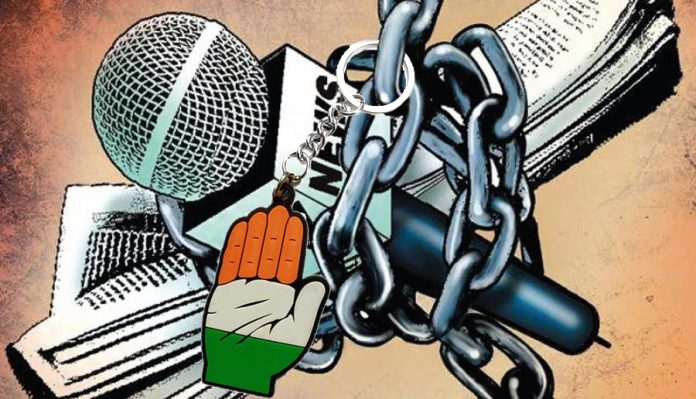TCN News
New Delhi-based Rights and Risks Analysis Group has released a report on media crackdown by the government during the COVID-19 lockdown detailing harassment of journalists and reporters working under critical circumstances.
The report titled ‘India: Media’s Crackdown During COVID-19 Lockdown’ discusses that immediately after the announcement of nationwide lockdown on March 24, the society as a whole “was moved by miseries and difficulties of migrant labourers.” As the situation dwindled, the crisis and challenges to cover their struggles became even difficult for journalists. The duration of the past three months, the report notes, in absence of food, shelter, transport and opportunity to work coupled with layoffs affected media persons as it made “bringing news in itself a challenge.”
Simultaneously, governments across the spectrum started hounding media for speaking about the plight of thousands of stranded workers on highways and roadways. Additionally, writ petitions that were filed in the public interest for redressal of grievances of migrant labourers in different parts of the country during the period, the BJP Government “prayed to suppress the freedom of opinion and expression relating to COVID-19 under the garb of deliberate or inaccurate reporting by the media.” Particularly web portals suffered the brunt of political parties and leaders who accused news websites as channels making attempts of “serious and inevitable potential panic in the larger section of the society.”
Speaking about the role of higher authorities, the Risk Analysis report has alleged that “the judgment of the Supreme Court did not stop various State governments to clamp down on the journalists.” It said that at such the time of a global pandemic it was the media who was actively covering ground reports and acted as messengers “by risking their lives to convey the vital news of various mismanagement, deficiencies, corruption, the hunger of the migrant workers and the lack of adequate PPE for doctors at hospitals.” While on duty, as of May 4, nearly 100 journalists in India were infected with the Coronavirus.
The analysis then indicates an unprecedented rise in harassment of journalists all over the country with Uttar Pradesh, Jammu and Kashmir and Himachal Pradesh “going on a spree to register First Information Reports against journalists.” In West Bengal, they were warned to behave “properly” and even threatened with action under the Disaster Management Act. Reporters of prominent news organizations like The Hindu, The Indian Express and The Wire were “targeted to suppress the truth” and some were even accused of “publishing one-sided stories during the coronavirus outbreak.”
Only in March, the total number of journalists to have faced arrest, registration of FIRs, summons or show cause notices, physical assaults, alleged destruction of properties and threats for reportage on COVID-19 was 55. It mentioned that the Editors Guild of India expressed concern over “a growing pattern of misuse of criminal laws to intimidate journalists in different parts of the country” which came soon after Mumbai Police had imposed Section 144 to obstruct ground reporting to cover the state’s handling of increasing COVID-19 infection cases.
The report then reveals that the highest number of attacks in journalists was reported from Uttar Pradesh (11 journalists), followed by Jammu & Kashmir (6 journalists) and Himachal Pradesh (5). Other states who followed suit were Tamil Nadu, West Bengal, Odisha, Maharashtra, Punjab, Delhi, Madhya Pradesh, Arunachal Pradesh, Assam, Bihar, Chhattisgarh, Gujarat, Karnataka, Nagaland, Telangana and Kerala. Even Andaman & Nicobar Islands marked assaults on media persons during the period. Some were tortured in detention while many have been slapped with offences under Sections 124A (sedition); 153A (promoting enmity between different groups on grounds of religion, race, place of birth, residence, language, etc., and doing acts prejudicial to maintenance of harmony); 182 (false information); 270 (malignant act likely to spread infection of disease dangerous to life); 500 (defamation); 501 (printing or engraving matter known to be defamatory); and Sections 66 (computer-related offences). Several other examples of brutal beating, custodial abuse and death threats against journalists have been recorded in the risk analysis report, accusing that “the government is responsible to create necessary conditions for press freedom but here, the Government of India seeks to silence the media.”
The report has noted that the Centre and State governments have acted at various levels of administration “under the garb of curbing fake news” to take action against journalists and now “it cannot claim to be promoting the freedom of opinion and expression.” In addition, it has also stated that “the police have been too compliant to register FIRs filed by the ruling parties.” Commenting on “the fragile atmosphere under which the media is operating in India,” the report has drawn attention to the inadequacy of the Press Council of India (PCI) in taking a stand against such suppression of freedom. The analysis urged PCI to do more as it is “the statutory body empowered to protect the rights of journalists,” but has “intervened suo moto in only four cases during the period.” The report concluded that if PCI and regulatory bodies continue to remain silent in the gag of press freedom, then “media remains at serious risks in India.”

